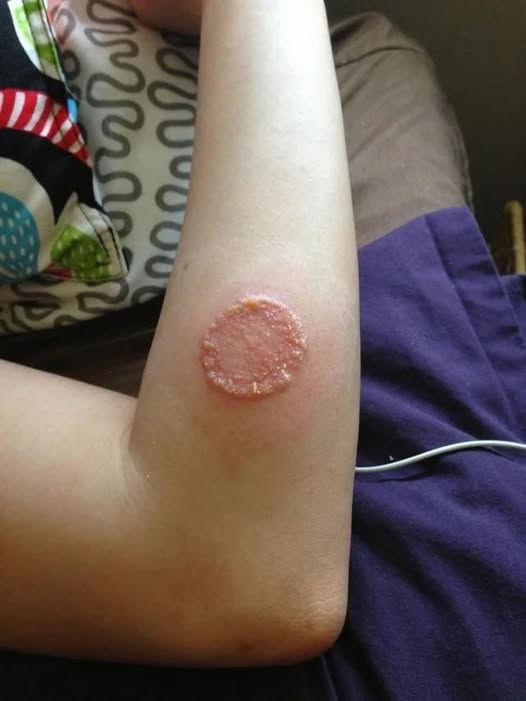A 55-year-old woman presented a rare and instructive case of Sweet syndrome (acute febrile neutrophilic dermatosis) after beginning a new inhalation therapy for chronic obstructive pulmonary disease (COPD). The case underscores the importance of clinical vigilance in primary care, especially when new symptoms emerge following medication changes.
The patient had a medical history of hypertension and COPD, with no allergies. She smoked about ten cigarettes a day and had been on enalapril for six years and inhaled formoterol for two. Due to worsening respiratory symptoms, her pulmonologist replaced formoterol with a combination of indacaterol and glycopyrronium inhaled capsules.
Just two days after starting the new medication, the patient developed painful, erythematous patches on her cheeks and neck, accompanied by mild fever. She reported no recent illness, no change in cosmetics or diet, and had used sunscreen during recent sun exposure. Given the severity and sudden appearance of the lesions, her primary care physician urgently referred her to Dermatology.
Dermatologists advised her to discontinue the new inhaler and prescribed oral corticosteroids. A skin biopsy and extensive lab work were performed, including a complete blood count, autoimmune antibodies, lupus anticoagulant, and serology tests. Within 48 hours, the skin lesions began to fade, and her pain decreased significantly. Blood tests revealed leukocytosis with neutrophilia but negative results for lupus and infectious causes.
Twenty days later, the biopsy confirmed Sweet syndrome, a rare inflammatory skin condition characterized by the sudden onset of painful, red papules or plaques, typically accompanied by fever and elevated white blood cells.
Understanding Sweet Syndrome
Sweet syndrome belongs to a group of disorders known as neutrophilic dermatoses, identified by dense accumulations of neutrophils in the skin. Clinically, lesions appear as tender, red or purple papules and plaques—often on the face, neck, arms, or upper torso. Systemic symptoms such as fever and fatigue are common.
The exact cause remains unclear. Research suggests that abnormal immune activation and cytokine release trigger the migration of neutrophils into the skin. Potential triggers include infections, malignancies (especially hematologic cancers), autoimmune diseases, and certain medications.
In this case, the timing strongly suggested a drug-induced Sweet syndrome linked to the newly introduced inhaler. While several medications have been associated with Sweet syndrome—including contraceptives, antiepileptics, antibiotics, antihypertensives, vaccines, and growth factors—this is the first reported case involving an inhaled indacaterol/glycopyrronium combination.
Diagnosis and Treatment
Diagnosis is based on clinical presentation, laboratory evidence of systemic inflammation (fever, leukocytosis, neutrophilia), and biopsy confirmation showing dense neutrophilic infiltrates. The differential diagnosis includes urticaria, contact dermatitis, drug eruptions, and lupus erythematosus.
The first-line treatment is systemic corticosteroids, which typically produce a rapid response—often within hours. Pain and fever subside quickly, and skin lesions usually resolve within a week. In recurrent or refractory cases, alternatives such as colchicine, dapsone, or potassium iodide may be considered.
In this patient, discontinuing the offending drug and initiating corticosteroid therapy resulted in a swift and complete recovery.
Clinical Implications
Though rare, Sweet syndrome should be part of the differential diagnosis when patients present with sudden painful skin eruptions accompanied by fever or leukocytosis, particularly after starting new medication. Early recognition and drug discontinuation are essential to prevent complications or recurrence.
Physicians must also rule out associated systemic diseases, since Sweet syndrome can be an early indicator of underlying conditions such as autoimmune disorders, infections, or malignancies.
This case serves as an important reminder that even inhaled medications, typically considered low-risk, can trigger systemic immune reactions. It emphasizes the need for careful monitoring of new treatments and prompt referral when unexpected adverse effects occur.
Ethical Considerations
The authors confirm adherence to all ethical protocols. No experiments were performed on humans or animals, and the patient provided informed consent for publication.
Conclusion
Sweet syndrome is rare but potentially serious, often misdiagnosed in early stages. Primary care providers play a vital role in recognizing unusual skin reactions, linking them to possible drug exposure, and initiating timely referrals. This case—the first to link Sweet syndrome to inhaled indacaterol and glycopyrronium—highlights the importance of staying alert to unexpected drug reactions, no matter how uncommon.



